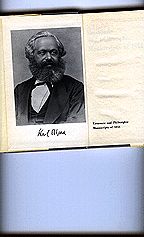|
terre thaemlitz writings 執筆 |
|
Means from an End - Terre Thaemlitz |

Track Listing
-
Inelegant Implementations
- 1. G1.A-J 2:01
2. G6.A-S 2:05
3. G3.A-L 2:50
4. G3.A-L 1:34
5. G7.A-T 2:19
6. G5.A-S 2:33
7. G4.A-S 2:09
- 8. Commentary 1:12
9. Resistance 0:49
10. Resignation 3:20
11. Transformative Nostalgia 3:09
- 12. Still Life w/Numerical Analysis 8:27
- 13. Means from an End 10:28
14. Reduction of Contents 3:11
15. Reintroduction of Contents I 1:09
16. Means to a Means 7:40
17. Reintroduction of Contents II 0:35
18. End to a Means 8:24
Introduction
Computer synthesis allows for the analysis and resynthesis of input sound sources - or to put it otherwise, it allows for the generation of a means (middling) from a previously constructed end point. Such generations use numeric equivalents of sound waves to establish ranges of numbers which are then edited or used as variables in equations applied to other sound sources. Associations between sound sources can be made more or less obvious, depending on one's technique and desire for explicit referentiality. This process bears similarities with general processes of social recontextualization, wherein previously constructed histories (end points) are filtered and reconstituted to advocate a particular cultural agenda (means, or middling of past events with transformative desire). As all analyses of such processes of social recontextualization take their footing in interpretive abstractions, any attempt for a total comprehension and/or control of socio-material processes is an impossibility of no interest to this project. Once this most traditional presupposition of popular Western cultural analysis is disposed of (as it has been countless times over the past century), one finds there is a vast difference between cultural processes which actively engage a multiplicity of constructed contents, and those which promote a rarefied and linear teleology of historical processes intended to conceal the construction of contents. It is hoped that these recordings contribute to a developing discourse of the former.

The functions of sound as a material, social, and socio-subjective medium lend to its simultaneous identification as a site, a discourse, and a form of 'personal expression.' The cultural implications of these multiplicious functionalities are anything but harmonious, despite the bourgeois liberal content of 'music's universality' to which the majority of producers, theorists, journalists, manufacturers, and listeners subscribe. For any assertion of universality must involve a concealment of circumstance, an erasure of the precise variations in context which allow such an assertion to be made at the expense and dismissal of alternative contents. Placed in the context of post-Industrial Capitalist marketplaces, such an alienation from context engages cultural processes not unlike those contributing to an alienation from labor. Sound becomes reified and appears to take on mystical properties of universal value in and of itself, distinct from processes of production, distribution and reception.
Obviously, a major impetus for this project is the re-clarification of a desire for contextuality (not to be confused with a desire for the re-clarification of context, or origin). A desire for contextuality takes as its presupposition limitations of contextual understanding. All re-clarifications of context are denied any essential origin. Rather, notions of 'origin' encapsulate a state of flux, elucidating both the ends and the beginnings of layered transformative contents. Every analysis is simultaneously approached as a site enacted within a social context, a discourse in dialogue with other analyses, and a form of 'personal expression' manifested of desires. Turning to the utilization of sound towards this end, Electroacoustique methodologies have come to philosophically encompass the complexities of this circumstance quite well. Whether the final sounds produced find their start in intangible mathematics or in analyses of material sound sources, the act of production remains one of overt contingency. And in a best-case scenario, the result presents a transformation of contents which requires a listener to reconsider the interpretive dynamics around such contingencies, therein deriving a means from an end.
Audio Advisory: This disc includes extreme frequency shifts and digital distortion. These sounds are intentional and are not indicative of problems with your audio equipment or the disc itself. Please start playback at a relatively low volume, being particularly careful when listening with headphones, and then adjusting the volume as desired. A wide range of playback experiences can be produced by using extremely low and high volume levels, as well as varying the use of speakers, headphones, or a combination of both.
Inelegant Implementations
- 1. G1.A-J 2:01
2. G6.A-S 2:05
3. G3.A-L 2:50
4. G3.A-L 1:34
5. G7.A-T 2:19
6. G5.A-S 2:33
7. G4.A-S 2:09

Statistical: Generate a control filter based on a waveform analysis of dialogue from leftist political actions or popular media. Multi-pass a 10 second excerpt of a jazz trio recording through the filter, applying random formant shifts to the filter with each pass so as to vary the pitch tracking and other parameters during resynthesis. Distortion and over saturation of the dynamic range are acceptable so long as a portion of the sounds generated fall within an audible spectrum.
Rationale: The use of jazz edits references mediums historically used to promote both subversive and bourgeois contents (a metaphor which may be extended to Electroacoustique musics such as this project). Dialogues from leftist political actions and popular media exemplify this multiplicity of contents. The generation of control filters derived from dialogues with contradictory contents mimics everyday processes of filtering contradictory social information in order to derive a sense of self and community. The 'inelegant implementation' of control filters during resynthesis, without regard to preserving the integrity of the original sound sources, represents the violent potential of distortions which are inherent in any cultural analysis or outline of social objectives. Accepting these distortions as preconditions rather than aberrations engages aesthetics which derive content through a contextualization of processes (as opposed to the aesthetics of formalist compositional strategies developed to ensure spectrally controlled results, while using vagaries such as 'universal appeal' and 'sound-as-sound' to disclaim the necessity for investigations into the cultural contexts and social processes which produce and utilize such musics). Such a focus on contexts of production, and the utilization of results, is complicated by this project's simultaneous functionality within dominant, institutionalized Avant Garde aesthetics akin to the above mentioned formalism.
-
1. G1.A-J ..., or "To be in a minority of one doesn't make you mad," or ...
2. G6.A-S ..., or "It's impossible to stop after just one," or ...
3. G3.A-L ..., or "Our task is to make government impossible," or ...
4. G2.A-O ..., or "Always remember where ya mutha fuckin' comin' from," or ...
5. G7.A-T ..., or "Abortion on demand and without apology," or ...
6. G5.A-S ..., or "Give her what she really wants," or ...
7. G4.A-S ..., or "No one can dictate who we love," or ...
Resistance to Change
- 8. Commentary 1:12
9. Resistance 0:49
10. Resignation 3:20
11. Transformative Nostalgia 3:09

Statistical: Edit, filter and resynthesize a 'politically regressive' pop standard so that the end result presents a restructuring of the original sound source while triggering an overtlynostalgic desire for that source.
Rationale: "I Love You Just The Way You Are," by Billy Joel, was chosen for its general ability to evoke a pleasant sense of nostalgia, as well as for its historical lack of appeal as an "anti-Feminist" anthem against concepts of change. A resistance to social change may be fueled more by a fear of unfamiliarity than any conspiratorial malice or cultural consensus that things are 'fine as they are.' Similarly, direct action groups must typically develop discourses primarily in response to their oppositions' fears of cultural loss (the threat of lower material and/or ethical qualities of life) rather than simply engaging 'positive' desires for social and/or personal betterment. In order for resistance to resign itself to change, resistors must find some semblance of their current objectives within new communal initiatives. Therefore, the long term impact of social change seems to involve transformations which engage nostalgia, rather than radical historical breaches of context which may result in repressed desires that erupt in conservative backlashes. The difficulty lies in adapting deconstructive discourses which evoke a sense of nostalgia sufficient to establish familiarity without overwhelming the resulting scenario with a desire for the past.
- Commentary: Analytic overview of social dynamics which may contribute
to a resistance to change.
Vocal transcript:
A resistance to social change is often times fueled by a sense of self-preservation not unlike that which compels others to enact social change. A successful strategy for change takes into account this need for self preservation - either by invoking a fear that one must adapt change to survive, or by removing the fear that one's security and self-integrity will be compromised by the change at issue. A successful strategy for direct action will employ both methods simultaneously.
For example, when negotiating with government or business agencies it is vital for an organization to be engaged in community outreach programs which allow other community members to actively participate in the determination of group objectives. This diminishes the resistance to change among community members so that, if negotiations with government or business agencies fail and direct action must be taken in the forms of protests and/or civil disobedience, a community's vocal advocacy for change may be called upon to heighten such agencies' sense of fear that they must adapt change or lose social viability.
It is important to note that at these times government and business agencies also engage in communal outreach projects, which are typically well funded, with the intention to generate fear that change will compromise a community's quality of life. Therefore, the long-term impact of a successful direct action can only be maintained if community members initially in opposition to the action attain a state of resignation to the change at hand. In order for this to happen, opponents must find some semblance of their own objectives within the new communal initiatives. In this manner, successful communal initiatives combine a sense of nostalgia and tradition along with transformation. The resulting familiarity reduces fear among opponents, and promote greater camaraderie between community members. - Resistance: Static and residual byproducts of resynthesis which inhibit clarity of contents during transformative processes.
- Resignation: Ensuing calm associated with a moment of resignation when resistance is diminished, followed by increased complexity via the introduction of new contents. The reintroduction of the initial sound source contributes to a strategic fiction of historical continuity.
- Transformative Nostalgia: The implementation of negotiated change, more transparent in its referentiality to the original sound source than the transitional processes of resistance and resignation, discloses an overt recontextualization of the past. Underlying the continual invocation and denial of the phrase "Don't go changing" is a rejection of the potential for sustained radical historical breach, other than as a cultural fiction intended to heighten the urgency for change.
Still Life w/Numerical Analysis
A brief moment of introspection.
A paralytic retreat into analysis, or an active declaration of circumstance?
Means from an End
- 13. Means from an End 10:28
14. Reduction of Contents 3:11
15. Reintroduction of Contents I 1:09
16. Means to a Means 7:40
17. Reintroduction of Contents II 0:35
18. End to a Means 8:24
Statistical: Combine diverse processes which illustrate, to varying degrees, sounds' relationships to site, discourse, and catharsis.
Rationale: (see introduction.)

- Means from an End: Playback over well balanced speakers is recommended in order to experience spatial dynamics which occur when channel-separated frequencies merge in the listening environment. This track was developed as a metaphorical tool for overcoming preconditioned responses in order to arrive at new applications of material processes. First listening typically involves overcoming an unfamiliarity with sustained high frequencies, followed by relaxation and a heightened awareness of listening processes during playback (this series of events encapsulates an experiential extension of thematics to "Resistance to Change"). A sensation of the eardrums tightening places the ears at a state of attention which is often sustained during a period within the track when the high frequencies subside. This physiological (material) adaptation and internalization of a response to particular frequencies serves as a metaphor for the adaptation of materialist practices which advocate an attempted disclosure of cultural processes. Note: During production I have found that uninterrupted playback of this track for more than four hours may result in nausea, nervousness and/or mild disorientation.
- Reduction of Contents: A minimization of the input sound source, resulting in a highly confined and linear extrapolation of contents. A notion of 'focus' emerges which is as restrictive as it is potentially informative.
- Reintroduction of Contents I: A self-analysis of elements produced for this disc, resulting in a recontextualized presentation of "1.Means from an End."
- Means to a Means: Citing transition as an endpoint-of-means from which to develop new means. The speaker proposes an existing revolutionary movement (transitional) as the platform from which to launch a new feminist agenda. The speaker is a man whose voice has been altered to sound more like a woman. It remains undisclosed whether this transformation was part of the speaker's initial broadcast, or occurred during production of this track - a condition which both contributes to and denies a disclosure of intentions.
- Reintroduction of Contents II: Recontextualization of selected elements contributing to the disc thus far, as well as the introduction of end points under consideration for implementation.
- End to a Means: A content of conclusion, manifesting the desire for a construct of momentary closure.